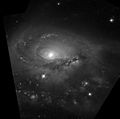| NGC 1961 | |
|---|---|
 NGC 1961 imaged by the Hubble Space Telescope | |
| Observation data (J2000 epoch) | |
| Constellation | Camelopardalis |
| Right ascension | 05h 42m 04.6477s [1] |
| Declination | +69° 22′ 42.375″ [1] |
| Redshift | 0.013122 [1] |
| Heliocentric radial velocity | 3934 ± 1 km/s [1] |
| Distance | 145.42 ± 27.36 Mly (44.586 ± 8.390 Mpc) [1] |
| Apparent magnitude (V) | 10.9 |
| Characteristics | |
| Type | SAB(rs)c [1] |
| Size | ~240,100 ly (73.62 kpc) (estimated) [1] |
| Apparent size (V) | 4.6′ × 3.0′ [1] |
| Other designations | |
| IRAS 05365+6921, IC 2133, Arp 184, UGC 3334, MCG +12-06-007, PGC 17625, CGCG 329-008 [1] | |
NGC 1961 is a spiral galaxy in the constellation Camelopardalis. It was discovered by German-British astronomer William Herschel on 3 December 1788. [2] It was also observed by Guillaume Bigourdan on 22 December 1891, causing it to be listed in the Index Catalogue as IC 2133. [2] Its velocity with respect to the cosmic microwave background for is 3,909±2 km/s, which corresponds to a Hubble distance of 188.0 ± 13.2 Mly (57.65 ± 4.04 Mpc ). [1] However, seven non redshift measurements give a much closer distance of 145.42 ± 27.36 Mly (44.586 ± 8.390 Mpc). [3]
Contents
The galaxy has been distorted, however no companion has been detected nor double nuclei that could show a recent merger. Its outer arms are highly irregular. Two long straight arms extend from the north side of the galaxy. [4] A luminous X-ray corona has been detected around the galaxy. [5] [6] NGC 1961 is the central member of the small group of nine galaxies, the NGC 1961 group. [4]



